Sponsored Links
The Smartboard
THE SMARTBOARD
by: Roe S. Riofrio
History
YOU MAY WATCH THE VIDEO FIRST BEFORE YOU PROCEED.
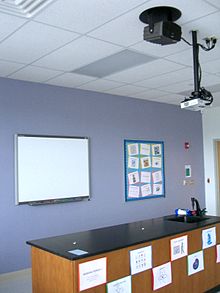 David Martin began SMART company in 1987 as the Canadian distributor for a U.S. projector company. The revenue it collected from the projectors was put into research and development on the SMART board interactive whiteboard, which was the first interactive whiteboard to provide touch control of computer applications and the ability to write over standard Microsoft Windows applications.[1]
David Martin began SMART company in 1987 as the Canadian distributor for a U.S. projector company. The revenue it collected from the projectors was put into research and development on the SMART board interactive whiteboard, which was the first interactive whiteboard to provide touch control of computer applications and the ability to write over standard Microsoft Windows applications.[1]
The Smart Board is an interactive whiteboard that uses touch detection for user input (for example scrolling and right mouse-click) in the same way as normal PC input devices. The Smart Board 800 series interactive whiteboard introduced a 'flick and scroll' feature.[2]
In December 2010, Smart introduced the lower-cost Smart Board 400 series interactive whiteboard.[3]
Technology
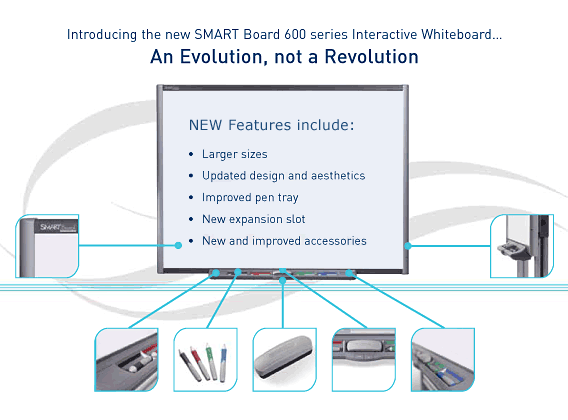
The Smart Board interactive whiteboard operates as part of a system that includes the interactive whiteboard, a computer,a projector and whiteboarding software - either Smart Notebook collaborative learning software for education, or Smart Meeting Pro software for business. The components are connected wirelessly or via USB or serial cables. A projector connected to the computer displays the desktop image on the interactive whiteboard. The whiteboard accepts touch input from a finger, pen or other solid object. Smart Board interactive whiteboards are also available as a front-projection flat-panel display – interactive surfaces that fit over plasma or LCD display panels.[4]
The Smart Board interactive whiteboard uses DViT (Digital Vision Touch) technology[5][6][7] to detect and respond to touch interactions on the interactive whiteboard surface. This camera-based touch technology for interactive whiteboards and interactive displays uses digital cameras and proprietary software and firmware to detect finger or pen contact with the screen. That contact is then interpreted as finger or pen activity. Smart has been using DViT technology in its interactive whiteboards since they developed the technology in 2003[8] and has continued to use DViT in many products since, including Smart Board interactive whiteboards, Smart Board interactive displays and the Smart Table interactive learning center.
Smart's digital ink operates by using an active digitizer that controls the PC input for writing capabilities such as drawing or handwriting. The Smart Board interactive whiteboard uses passive pen tools, which means that no technology is housed in the pen tool to use digital ink or determine color. All digital ink options can be selected from the Smart Board Pen Tray.
Pen tray
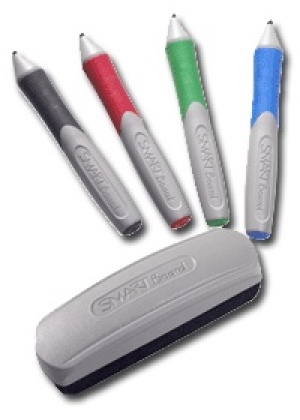 Most models of Smart Board include a pen tray on the front of the interactive whiteboard that holds two to four plastic pen tools and an eraser. The pen tools have neither electronic components nor ink - the technology is in the pen tray. When a pen tool is removed from its slot in the tray, an optical sensor recognizes its absence. Smart Board software processes the next contact with the interactive whiteboard surface as a pen action from the pen tool that resides in the corresponding slot. Older models of the Smart Board interactive whiteboard features slots for black, blue, red and green pen tools, although a control panel can be used to change the color of the digital ink or change the pen tools to colored highlighters.
Most models of Smart Board include a pen tray on the front of the interactive whiteboard that holds two to four plastic pen tools and an eraser. The pen tools have neither electronic components nor ink - the technology is in the pen tray. When a pen tool is removed from its slot in the tray, an optical sensor recognizes its absence. Smart Board software processes the next contact with the interactive whiteboard surface as a pen action from the pen tool that resides in the corresponding slot. Older models of the Smart Board interactive whiteboard features slots for black, blue, red and green pen tools, although a control panel can be used to change the color of the digital ink or change the pen tools to colored highlighters.
Once a pen tool is removed from its slot, users can write in the selected color with that pen tool, a finger or any other object. Similarly, when the eraser is removed from its position in the pen tray, the software processes the next contact with the screen as an erasing action, whether the contact is from the eraser, the user’s finger or another object. As such, the potential exists that using a particular pen, such as the blue pen, may not result in blue digital ink if all objects – colored pens and eraser tool – have not been replaced in their corresponding locations on the pen tray. The Smart Board also registers the last pen tray tool picked up as the active tool. This means that when a user picks up the black pen and then picks up the red pen before putting the black pen down, the interactive whiteboard will register red ink, rather than black. In order to write in black digital ink, a pen needs to be put back in the red slot.[9]
The Smart Board 800 series interactive whiteboard has only two pens and the color is determined by pressing a black, blue, red or green button found on the pen tray.[10]
Below the pen tray are two buttons that, when pressed, allow the user to do right click functions such as copy, cut, paste, select all, etc., or bring-up a traditional on-screen QWERTY keyboard, which allows the user to type in letters, words or numbers. These keys also, when pressed, allow you to calibrate the touch screen. Other models, such as the Smart Board interactive display, include a black pencil tool which incorporates a digital ink eraser. Unlike the Smart Board, the interactive display models use active pen technology.
Many companies have since developed products that either support Smart Boards or compete with Smart Boards using similar technologies. As with any famous product, a brand name can be mis-applied to its competitors. An example of a company that has developed supporting products for Smart Boards is Copernicus Educational Products. Examples of companies that have developed similar products are PolyVision, Promethean, and Mimio.
Resistive technology
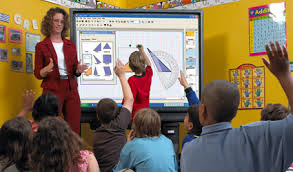 The earlier Smart Board 600 series interactive whiteboards use resistive technology. A flexible plastic front sheet and hard backboard are coated with a thin resistive film. The resistive sides of each are separated by an air gap of two-thousandths of an inch, or about the width of two human hairs. Pressure applied to the surface of the front sheet closes the gap and is registered as a contact point. This contact point is then converted from an analog signal to a serial data stream which is sent to a computer for further processing. This technology can process contact from a finger, pen tool or any device – such as a pointer.
The earlier Smart Board 600 series interactive whiteboards use resistive technology. A flexible plastic front sheet and hard backboard are coated with a thin resistive film. The resistive sides of each are separated by an air gap of two-thousandths of an inch, or about the width of two human hairs. Pressure applied to the surface of the front sheet closes the gap and is registered as a contact point. This contact point is then converted from an analog signal to a serial data stream which is sent to a computer for further processing. This technology can process contact from a finger, pen tool or any device – such as a pointer.
Software
 Smart Notebook software is included with the Smart Board and allows users to compile notes, images, and other media into virtual notebooks which can be projected and edited using the Smart Board itself. Other Smart software products, like Smart Response interactive response, the Smart Document Camera, Smart Ideas concept-mapping software, Smart Notebook Math Tools and Smart Slate wireless slate are designed for use.
Smart Notebook software is included with the Smart Board and allows users to compile notes, images, and other media into virtual notebooks which can be projected and edited using the Smart Board itself. Other Smart software products, like Smart Response interactive response, the Smart Document Camera, Smart Ideas concept-mapping software, Smart Notebook Math Tools and Smart Slate wireless slate are designed for use.
The Smart Board interactive whiteboard works with any program loaded or available on the host computer. Some applications commonly used with the Smart Board are Microsoft PowerPoint, Excel, Word, and AutoCAD.
Uses
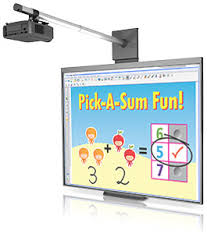 Uses for the Smart Board include teaching,[11] training, conducting meetings, and delivering presentations. It has also been used on the Discovery Channel television show MythBusters.[12]
Uses for the Smart Board include teaching,[11] training, conducting meetings, and delivering presentations. It has also been used on the Discovery Channel television show MythBusters.[12]
In Datacloud: Toward a New Theory of Online Work, Johndan Johnson-Eilola describes a specific computer-supported space for collaboration: the Smart Board. According to Johnson-Eilola, a “Smart Board [interactive whiteboard] system provides an... intelligent whiteboard surface for work” (79). Johnson-Eilola asserts that “[w]e are attempting to understand how users move within information spaces, how users can exist within information spaces rather than merely gaze at them, and how information spaces must be shared with others rather than being private, lived within rather than simply visited” (82). He explains how the Smart Board interactive whiteboard system offers an information space that allows his students to engage in active collaboration.[citation needed] He makes three distinct claims regarding the functionality of the technology: 1) the Smart Board allows users to work with large amounts of information, 2) it offers an information space that invites active collaboration, and 3) the work produced is often “dynamic and contingent” (82).[13]
References
Photos: www.google.com/image
- "The History of SMART". SMART. Retrieved 28 May 2014.
- [1]. smarttech.com[dead link][dead link]
- SMART Introduces Entry-Level SMART Board Interactive Whiteboard 14 December 2010
- The Ledger West Area Gets Smart With Technology, 27 November 2007
- "SMART Technologies Inc. invents new technology for touch-sensitive displays". bobsguide.com. Retrieved 2012-05-23.
- GOLIATH: Business Knowledge on Demand Smart Digital Vision Touch technology, 1 November 2003
- The Free Dictionary by FARLEX DViT
- "SMART Announces Touch Gestures for DViT". Creativemac.digitalmedianet.com. Retrieved 2012-05-23.
- SMART Board 600 series interactive whiteboard SMART Technologies
- SMART Board 800 series interactive whiteboard SMART Technologies
- Becta Evaluation of Primary Schools Whiteboard Expansion Project, commissioned by the British Educational Communications and Technology Agency (Becta), October 2007
- SMART Board on MythBusters SMART Technologies Facebook page
- Johnson-Eilola, Johndan. Datacloud: Toward a New Theory of Online Work. Cresskill, NJ: Hampton Press, Inc., 2005. Print.





Add new comment